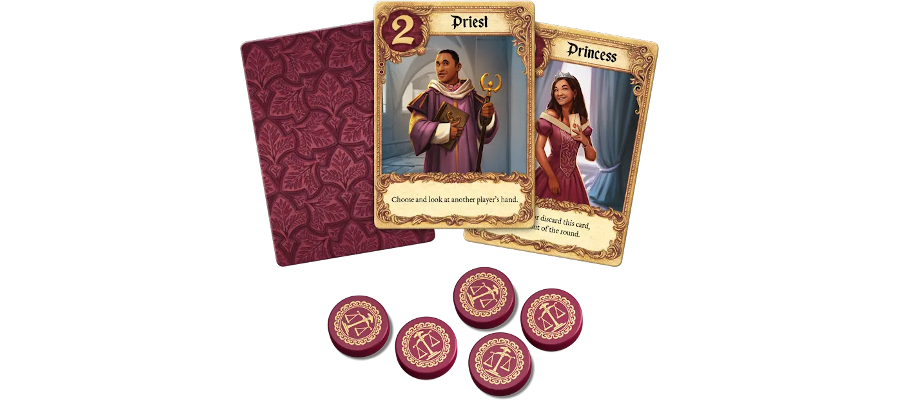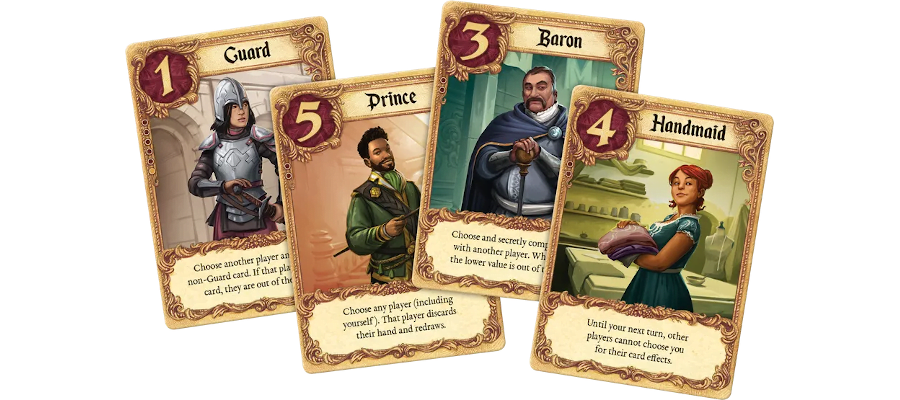It used to be that Love Letter was a great start to a modern niche board game collection. Now, it is possible for Love Letter to be a modern niche board game collection. At this point, the boardgamegeek site lists over thirty four variant reimplementations, alternate boxes or art styles or licensed versions of Love Letter, with varying sizes and scales. So steep was this proliferation I was seriously tempted to do a gag of reviewing a different copy of Love Letter every month for a year only to realise I wouldn’t get through more than half of them doing that.

For the unfamiliar, Love Letter is a tiny card game — usually something like eighteen cards — originally developed by Seiji Kanai, and as burly as it is having thirty iterations of a game in your developer credits, Love Letter represents about half of Kanai’s work. And you might think in the same vein as heavily franchised movies or long-running soap opera TV shows, is there being a lot of something a signal that it’s potentially a bit bad, right?
But no.
I think Love Letter is great.
This diversity brings with it a raftload of asterisks, mind you. Every statement I can make about Love Letter is going to include a *, because there’s always a caveat or exception somewhere. I’m describing, as best I can, the core engine of the basic game, which is the one I’m most familiar with. But the one I’m most familiar with is the Kanai collection version, which is different to the AEG common version, which – I’m already complicating things.
Let’s just describe how the game works. Love Letter is a card game with a tiny pool of potential cards, and most of the game rules you need to know fit on the back of a reminder card. There are nine types of card, with most of those cards being unique in the deck. Your hand in this game is one card, then you draw a card at the start of your turn and play one of the two cards in your hand. You get the effect on that card, and then the winner of the game is the player with the highest value card in their hand at the end of the game. This simple game play loop means that you can rip through a game of Love Letter really quickly, so quickly that getting through to the end of this loop doesn’t end the game, but instead awards you a token, and you play to a number of tokens.
There were a lot of invisible *s in that paragraph, trust me.

The lore of this game at core can be a tiny bit confusing at first. I didn’t think it would be, but when I talk to people about Love Letter about how its mechanics express its narrative, I get three basic responses:
- It’s weird that you’re trying to win this Princess
- Why can the King send a love letter to the Princess?
- It has narrative?
And it’s not unreasonable that a game interface confuses players and then those players are confused. That’s a totally reasonable thing and I don’t want to talk about how people fail to grasp a game’s narrative as if they did something wrong. Because a game this small has such a simple narrative and so few points of interface to explain them that it’s really easy to neglect that in the play loop.
The narrative is that you are trying to deliver a love letter to a princess. The cards you draw and play are the people you’re turning to for favours in your attempt to get that letter through to the princess. That’s why you can’t do anything with the princess card, and you can lose if you’re caught with her by the guards, because if you’re getting a favour from the princess about delivering the letter, then all you need to do is wait for those people to stop fussing around trying to get to her. Similarly, you might be able to get a favour from her dad, the King, but that is a bit of a giveaway to people that you’ve got the favour of the royal court.

I don’t get to play Love Letter much. I have a single copy, my beautiful black-and-white box Kanai Collection version and it just isn’t the kind of game I get to the table very much. It’s a game that wants to be fast, it wants to work between other larger games, and it wants to be with people who are competitive and like working out tells and strategies with other players. It’s pretty light on its theme, but it’s very engaging if you like looking at intricate game systems.
On the other hand if you’re a big roleplayer type, if you want a cooperative game, if you don’t like thinking through a big chunk of possible game permutations, then there’s nothing here for you in this raw little node of systems. But it’s that system that fascinates me, because every time I play Love Letter I’m struck thinking about the way the game design works, the way it permeates, the way it can be made, the way it can be designed.
Like, there are a bunch of different designs I can see based around it. Imagine a game which is a big deck of cards, shuffled up at random, and you play a round of Love Letter with just the top eighteen. What if the cards are played at the same time? What if the goal is cooperative? What if your aim is to foist cards? What if there are factions and you want to win with high numbers in one direction or low in another direction? What can you do with this tight little system?
Every time I play Love Letter, I turn the crystal of its beauty and see new refractions. It was one of the first microgames I played and showed me the scope of a small game system. It showed me how little material you could use to express a game and it showed me that people would like a game in that space. I wonder how many of my games I can describe as variants of Love Letter. I wonder how much Love Letter can be shown as a simplified academic flowchart of possibility matrices.
It’s so clever.